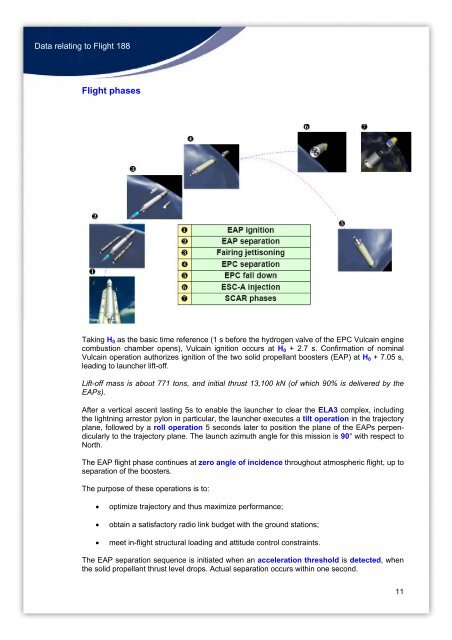Flight 188 - uppsagd
Flight 188 - uppsagd Flight 188 - uppsagd
Data relating to Flight 1883. Mission V188Payload missionThe main mission of flight 188 is to place the HERSCHEL and PLANCK scientific payloads intopractically an escape orbit:Apogee altitude(with an apogee radiusPerigee altitude1,193,622 km1,200,000 km)270 kmInclination 6.0°Perigee argument 162°Ascending node longitude -108.0°(*)(*) in relation to a fixed axis, frozen at H 0 - 3s and passing through the ELA3 launch complex inKourou.The mass of HERSCHEL is 3,402 kg, with 1,921 kg for PLANCK.Allowing for the adaptors and the SYLDA 5 structure, total performance required from thelauncher for the orbit described above is 6,001 kg. Although total payload mass for this flight issubstantially less than the maximum capacity of the A5ECA launcher (of the order of 9,500 kgfor a standard GTO orbit inclined at 6°), the performance required from the launcher is veryclose to maximum performance level. This is due to the target orbit (practically an escape orbitto reach second Lagrange point L2).10
Data relating to Flight 188Flight phasesTaking H 0 as the basic time reference (1 s before the hydrogen valve of the EPC Vulcain enginecombustion chamber opens), Vulcain ignition occurs at H 0 + 2.7 s. Confirmation of nominalVulcain operation authorizes ignition of the two solid propellant boosters (EAP) at H 0 + 7.05 s,leading to launcher lift-off.Lift-off mass is about 771 tons, and initial thrust 13,100 kN (of which 90% is delivered by theEAPs).After a vertical ascent lasting 5s to enable the launcher to clear the ELA3 complex, includingthe lightning arrestor pylon in particular, the launcher executes a tilt operation in the trajectoryplane, followed by a roll operation 5 seconds later to position the plane of the EAPs perpendicularlyto the trajectory plane. The launch azimuth angle for this mission is 90° with respect toNorth.The EAP flight phase continues at zero angle of incidence throughout atmospheric flight, up toseparation of the boosters.The purpose of these operations is to:• optimize trajectory and thus maximize performance;• obtain a satisfactory radio link budget with the ground stations;• meet in-flight structural loading and attitude control constraints.The EAP separation sequence is initiated when an acceleration threshold is detected, whenthe solid propellant thrust level drops. Actual separation occurs within one second.11
- Page 1: KOUROUMay 2009ARIANE 5Data relating
- Page 4 and 5: Data relating to Flight 1882. Launc
- Page 6 and 7: Data relating to Flight 188Compared
- Page 8 and 9: Data relating to Flight 188Nose fai
- Page 12 and 13: Data relating to Flight 188This is
- Page 14 and 15: Data relating to Flight 18814
- Page 16 and 17: Data relating to Flight 188The foll
- Page 18 and 19: Data relating to Flight 188LAGRANGE
- Page 20 and 21: Data relating to Flight 188Herschel
- Page 22 and 23: Data relating to Flight 188The PLAN
- Page 24 and 25: Data relating to Flight 1885. Launc
- Page 26 and 27: Data relating to Flight 188Kourou:
- Page 28 and 29: Data relating to Flight 1887. Final
- Page 30 and 31: Data relating to Flight 188FLUID SY
- Page 32 and 33: Data relating to Flight 1888. Fligh
- Page 34 and 35: Data relating to Flight 1889. EADS
Data relating to <strong>Flight</strong> <strong>188</strong><strong>Flight</strong> phasesTaking H 0 as the basic time reference (1 s before the hydrogen valve of the EPC Vulcain enginecombustion chamber opens), Vulcain ignition occurs at H 0 + 2.7 s. Confirmation of nominalVulcain operation authorizes ignition of the two solid propellant boosters (EAP) at H 0 + 7.05 s,leading to launcher lift-off.Lift-off mass is about 771 tons, and initial thrust 13,100 kN (of which 90% is delivered by theEAPs).After a vertical ascent lasting 5s to enable the launcher to clear the ELA3 complex, includingthe lightning arrestor pylon in particular, the launcher executes a tilt operation in the trajectoryplane, followed by a roll operation 5 seconds later to position the plane of the EAPs perpendicularlyto the trajectory plane. The launch azimuth angle for this mission is 90° with respect toNorth.The EAP flight phase continues at zero angle of incidence throughout atmospheric flight, up toseparation of the boosters.The purpose of these operations is to:• optimize trajectory and thus maximize performance;• obtain a satisfactory radio link budget with the ground stations;• meet in-flight structural loading and attitude control constraints.The EAP separation sequence is initiated when an acceleration threshold is detected, whenthe solid propellant thrust level drops. Actual separation occurs within one second.11



